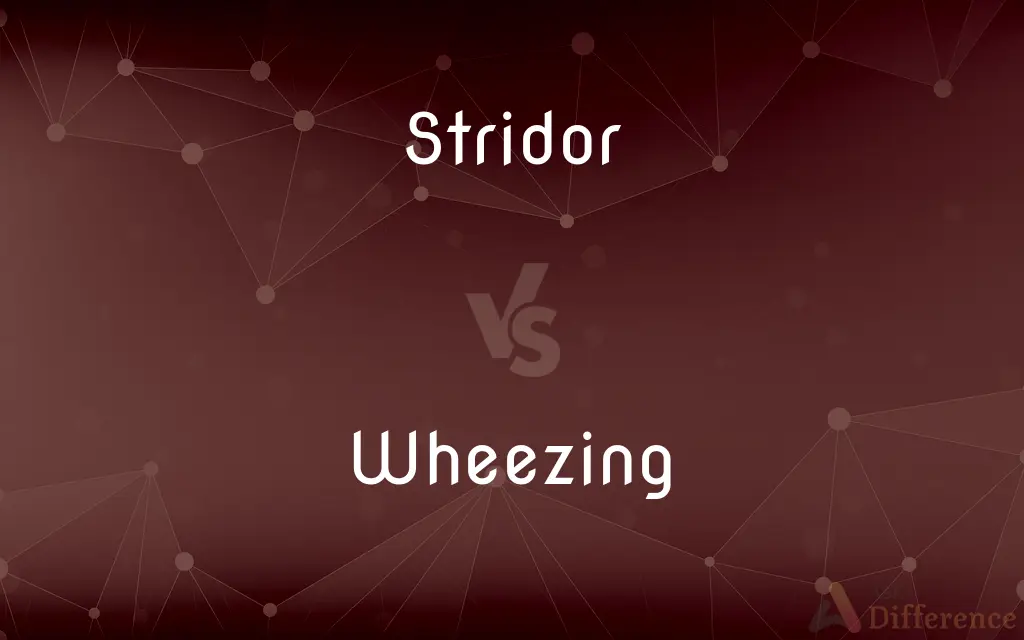Stridor vs. Wheezing — What's the Difference?
By Tayyaba Rehman — Updated on October 29, 2023
Stridor is a high-pitched, harsh sound caused by upper airway obstruction; wheezing is a high-pitched whistle due to lower airway obstruction.

Difference Between Stridor and Wheezing
Table of Contents
ADVERTISEMENT
Key Differences
Stridor is a sound originating from the upper part of the respiratory system, specifically the trachea or larynx. Wheezing, on the other hand, is a sound from the lower respiratory tract, especially the bronchi or bronchioles. Stridor often presents itself as a high-pitched, harsh, and loud noise noticeable when a person breathes. In contrast, wheezing is characterized by a high-pitched whistle which is typically heard during exhalation but can be present during inhalation as well.
Stridor often indicates a life-threatening condition due to the obstruction in the upper airways which can be due to tumors, foreign objects, or infections. Wheezing is commonly associated with asthma, chronic obstructive pulmonary disease (COPD), or other conditions causing constriction or inflammation of the bronchioles. While stridor is generally audible without the aid of equipment, wheezing is often best heard with a stethoscope placed over the patient's chest or back.
Diagnosis and treatment for stridor require prompt attention since it deals with the upper airway, a critical part of the respiratory system. However, wheezing, while concerning, may be associated with chronic conditions that need long-term management. In children, croup or epiglottitis often presents with stridor, requiring immediate medical care. Wheezing in children can be a sign of asthma, bronchiolitis, or allergies.
Comparison Chart
Origin
Upper respiratory system (trachea, larynx)
Lower respiratory system (bronchi)
Sound Characteristics
High-pitched, harsh sound
High-pitched whistling sound
ADVERTISEMENT
Common Causes
Tumors, foreign objects, infections
Asthma, COPD, allergies
Audibility
Often audible without equipment
Best heard with a stethoscope
Associated with Children
Croup, epiglottitis
Asthma, bronchiolitis, allergies
Compare with Definitions
Stridor
Stridor is most often audible during inhalation.
The paramedic immediately recognized the stridor sound during the patient's inhalation.
Wheezing
Wheezing indicates airway constriction or inflammation.
His exposure to cat fur resulted in wheezing due to an allergic reaction.
Stridor
Stridor originates from the upper airway obstruction.
The doctor confirmed that the stridor was due to a foreign object lodged in the trachea.
Wheezing
Wheezing originates from the lower airways.
Her persistent cough was accompanied by wheezing from her bronchi.
Stridor
Stridor can be congenital or acquired.
In some cases, infants are born with conditions that can cause stridor.
Wheezing
Wheezing can occur during inhalation or exhalation.
During the examination, the doctor noted wheezing during both the inhale and exhale.
Stridor
Stridor is a high-pitched, harsh respiratory sound.
She quickly noticed the child's alarming stridor as he struggled to breathe.
Wheezing
Wheezing is a high-pitched whistling sound.
After running in the cold, he started wheezing noticeably.
Stridor
Stridor (Latin for "creaking or grating noise") is a high-pitched extra-thoracic breath sound resulting from turbulent air flow in the larynx or lower in the bronchial tree. It is different from a stertor which is a noise originating in the pharynx.
Wheezing
Wheezing is often associated with asthma and allergies.
The pollen in spring always aggravates her asthma, leading to bouts of wheezing.
Stridor
A harsh, shrill, grating, or creaking sound.
Wheezing
To breathe with difficulty, producing a hoarse whistling sound.
Stridor
(Medicine) A harsh, high-pitched sound in inhalation or exhalation.
Wheezing
To make a sound resembling laborious breathing.
Stridor
A harsh, shrill, unpleasant noise.
Wheezing
To produce or utter with a hoarse whistling sound
The old locomotive wheezed steam.
Stridor
(medicine) A high-pitched sound heard on inspiration resulting from turbulent air flow in the upper airway usually indicative of serious airway obstruction.
Wheezing
A wheezing sound.
Stridor
A harsh, shrill, or creaking noise.
Wheezing
(Informal) An old joke.
Stridor
A whistling sound when breathing (usually heard on inspiration); indicates obstruction of the trachea or larynx
Wheezing
Chiefly British A clever scheme.
Stridor
Stridor may indicate a life-threatening situation.
The sudden onset of stridor in the patient raised alarms about a severe airway blockage.
Wheezing
The quality or symptom of breathing with an audible wheeze
Wheezing
Present participle of wheeze
Wheezing
Relating to breathing with a whistling sound
Common Curiosities
Where does stridor typically originate from?
Stridor originates from the upper respiratory system, such as the trachea or larynx.
What is wheezing?
Wheezing is a high-pitched whistle that originates from lower airway obstruction.
Is stridor a sign of asthma?
No, stridor is typically associated with upper airway obstructions, while asthma is associated with wheezing.
Is wheezing always related to asthma?
No, while asthma is a common cause, wheezing can also be due to other conditions like COPD or infections.
Is stridor audible without instruments?
Yes, stridor is often audible without the aid of equipment.
What is stridor?
Stridor is a high-pitched, harsh sound caused by upper airway obstruction.
Where does wheezing typically come from?
Wheezing originates from the lower respiratory system, specifically the bronchi or bronchioles.
Are both stridor and wheezing signs of respiratory distress?
Yes, both can indicate respiratory distress, but their causes and locations differ.
Can allergies cause wheezing?
Yes, allergies can lead to inflammation in the bronchioles, causing wheezing.
What conditions in children can cause stridor?
Croup and epiglottitis are two conditions in children that can present with stridor.
Can both stridor and wheezing occur together?
While rare, it's possible if there are obstructions or issues in both the upper and lower airways.
Can infections lead to stridor?
Yes, infections in the upper airway can cause swelling leading to stridor.
How is wheezing typically diagnosed?
Wheezing is often diagnosed using a stethoscope during a physical examination.
Is stridor always a medical emergency?
While not always, stridor can indicate a life-threatening condition and should be promptly evaluated.
What treatments are available for wheezing?
Treatments vary depending on the cause but may include bronchodilators, steroids, or antihistamines.
Share Your Discovery

Previous Comparison
Forward vs. Aft
Next Comparison
Lemma vs. TheoremAuthor Spotlight
Written by
Tayyaba RehmanTayyaba Rehman is a distinguished writer, currently serving as a primary contributor to askdifference.com. As a researcher in semantics and etymology, Tayyaba's passion for the complexity of languages and their distinctions has found a perfect home on the platform. Tayyaba delves into the intricacies of language, distinguishing between commonly confused words and phrases, thereby providing clarity for readers worldwide.
















































